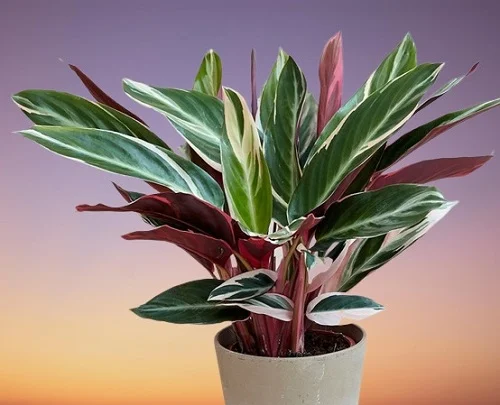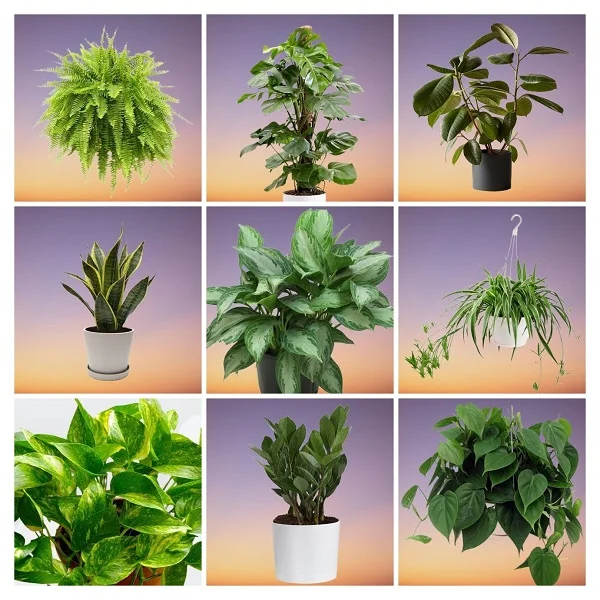Stromanthe Triostar (Stromanthe sanguinea) Indoor Care, Propagation, Problems and Solutions
Some links in this post may be affiliate links
Stromanthe triostar (Stromanthe sanguinea) prospers in bright indirect light, warm and humid conditions and consistently moist, rich, well-drained, all purpose soil coupled with monthly feeding in the growing season.
Stromanthe sanguinea also called Tricolor Prayer Plant is one of the popular tropical foliage plants grown for its large, beautifully, patterned leaves that will add a splash of color in any plant collection.

Botanical name: Stromanthe sanguinea
Family: Marantaceae
Common name: Stromanthe triostar, Triostar Stromanthe, Tricolor Prayer Plant
Origin
Stromanthe sanguinea is native to the tropical regions of the Americas from Mexico to Trinidad to northern Argentina.
Size
Stromanthe triostar is a slow-growing, herbaceous, perennial plant which grows to a height of about 6 feet and a about 6 feet in diameter. It is one of the best plants for the living room where it will create a great first impression.
Toxicity
Stromanthe sanguinea is non-toxic to both humans and pets. They are safe to grow indoors.
Related Plants
Stromanthe triostar is related to the Calatheas, Marantas and Ctenanthe. These groups of plants are sometimes commonly called Prayer Plants in reference to their curious characteristic of closing their leaves at night.
Where to Buy
Are you looking to add Stromanthe triostar to your plant collection? You may get them online from Etsy (Link to Etsy) or from Amazon (Link to Amazon).
Stromanthe sanguinea Care Indoors
Stromanthe triostar (Stromanthe sanguinea) thrives in bright indirect light, average warmth of 16-260C, humidity of 60-80% and consistently moist, fertile, well-drained, all purpose potting soil coupled with monthly feeding during the growing season.
Stromanthe sanguinea requires regular pruning to keep it neat and tidy as well as rejuvenate growth. Repotting is only necessary when it becomes pot-bound as it grows best when slightly root-bound. Keep reading for more on these growing conditions and how to achieve them.

Light requirements
Stromanthe triostar grows best in bright indirect light (dappled light). Keep it away from direct sunlight as it can lead to sunburn on leaves and washed out leaves.
Too little light will result in loss of the beautiful variegation. Therefore, if the natural light is inadequate, you may grow Triostar Stromanthe under grow lights. Take a look at these full spectrum grow lights available on Amazon.
Regularly turn the pot to ensure that the plant receives light on all sides for uniform growth and prevent leggy growth.
Watering
Water Stromanthe triostar thoroughly and allow the top 1-2 inches of soil to dry out between waterings to keep the soil moist at all times during the growing season.
Decrease watering in the cold season as growth is minimal at this time to maintain the soil slightly but do not let the soil dry out completely.
Being a tropical plant, water the Triostar Stromanthe with water that is at room temperature to avoid shocking the plant which can result in reduced growth. It is also sensitive to chemicals dissolved in water, therefore, water with water that is free of chlorine and flourides.
Ensure the pot has a drainage hole to prevent the soil from getting soggy as it can lead to root-rot. Avoid wetting the foliage during watering or water from the bottom instead to prevent fungal infestation.
Temperature and Humidity
Stromanthe triostar prefers average warmth of 16-260C. Keep it away from cold drafts and sudden changes in temperature as they can result in reduced growth and death of the plant.
Stromanthe triostar requires high humidity of 60-80% to thrive. To raise humidity, set the pot on a wet pebble tray or use a cool mist humidifier. You may also grow the plant in a terrarium as a high humidity can be maintained in a terrarium.
Clean the leaves regularly by damp-wiping with a soft cloth to keep them clean and neat as well as discourage pests infestations. Ascertain that there is proper circulation to discourage fungal diseases.
Fertilizer
Feed Stromanthe triostar with a balanced, liquid fertilizer once monthly through out the growing season for lush growth.< Withhold feeding in the cold season as growth is minimal and feeding at this time can lead to fertilizer burn.
Occasionally, flush out accumulated salts (which may have arisen from the water or fertilizers) from the soil by running for a few minutes a steady stream of water through the soil until it comes out through the drainage holes. Repeat the process several times.
Potting Soil
The best potting soil for Stromanthe triostar should be rich in organic matter and free-draining to avoid getting soggy soil. All purpose potting mixes are ideal for this plant.
Repotting
Repot Stromanthe triostar the beginning of the growing season only when it has become root-bound. Use a pot 1 size larger than the current one.
Stromanthe does not like to sit in soggy soil, therefore, ensure the soil is free-draining and the pot has a drainage hole as soggy soil can lead to root-rot.
The large Stromanthe plants can be divided at the time of repotting and the splits used to propagate new plants. Check out these pots with multi-mesh drainage holes on Amazon.
Pruning
Pruning Stromanthe triostar is easy as it involves removal of dead and yellow foliage to maintain the plant neat and attractive. Cutback the stems at the beginning of the growing season to rejuvenate growth and encourage a compact growth.
Propagation
Stromanthe sanguinea propagation can be done at the beginning of the growing season by plant division.
How to propagate Stromanthe triostar by plant division
Water the Stromanthe triostar thoroughly at least 1 day before to make it easier to divide and also hasten establishment. A well hydrated plant suffers less shock and takes a shorter time to take root.
Take the Stromanthe triostar out of its pot and divide it into several sections. Ensure each section has some roots inorder to hasten rooting.
Pot the sections into individual pots in moist, free-draining soil. Ensure the pots have a drainage hole to prevent the soil from getting soggy as it can lead to rotting.
Cover the pots with clear polythene to create a greenhouse effect and maintain warm humid conditions which hasten establishment of the plants.
Place the pots in a warm, well-lit place until new growth has emerged in the sections.
Gradually remove the polythene cover over a period of two weeks to acclimatize the new plants.
Then move the set up to a cool, shaded place and maintain the soil moist until the new Stromanthe sanguinea are well established after which routine care can begin.

Stromanthe sanguinea Problems
Stromanthe sanguinea problems include brown leaf tips and edges, rotting, discolored leaves, stunted growth, pests and diseases among others. Keep reading for more on these problems and how to fix them.
Pests
Common pests in Stromanthe triostar are mealy bugs, aphids, scale insects and spider mites. Isolate the affected plant to prevent spread to the other plants and treat it with neem oil as directed on the instructions label.
Diseases
Stromanthe triostar is prone to leaf spot disease due to the humid conditions that it prefers. Isolate the affected plant to prevent spread to the other plants and treat it for the disease.
Curled, spotted leaves and lower leaves yellowing
Stromanthe triostar curled, spotted leaves and lower leaves yellowing are due to underwatering. Water the plant thoroughly and keep the soil moist at all times during the growing season. Do not let the soil dry out between waterings but reduce watering during the cold season. Read more on how to water houseplants the right way.
Brown leaf tips and edges
Stromanthe triostar brown leaf tips and edges is due to too dry air (low humidity) as it is very sensitive to low air humidity. To elevate humidity, set the pot on a wet pebble tray or use a cool mist humidifier. You may also grow the plant in a terrarium where high humidity can be maintained easily. Learn more on how to increase humidity for houseplants.
Limp and rotting stems
Stromanthe triostar limp and rotting stems are due to too cold air and or too wet soil. At this point, the plant may be too far gone to be saved.
To prevent limp and rotting stems in the future, maintain an average warmth of 16-260C. Protect it from cold drafts and sudden changes in temperature. Avoid soggy soil by ensuring that the pot has a drainage hole and that the soil is free-draining.
Discolored or scorched leaves
Stromanthe triostar discolored or scorched leaves are due to exposure to direct sunlight on your plant. Move the plant to a shaded spot or protect it from direct sunlight to prevent eventual death.
Brown, dry leaf tips and stunted growth
Stromanthe triostar brown and dry leaf tips accompanied by stunted growth are an indication of spider mites infestation due to the air being too dry. Remove the dead growth and set the pot on a wet pebble tray to raise humidity or grow the plant in a well-lit bathroom and other moist areas in the home.
You liked it? Share on social media.
Related Content
Amazon Associates Disclosure
Homeplantsguide.com is a participant in the Amazon Services LLC Associates Program, an affiliate advertising program designed to provide a means for sites to earn advertising fees by advertising and linking to amazon.com.





